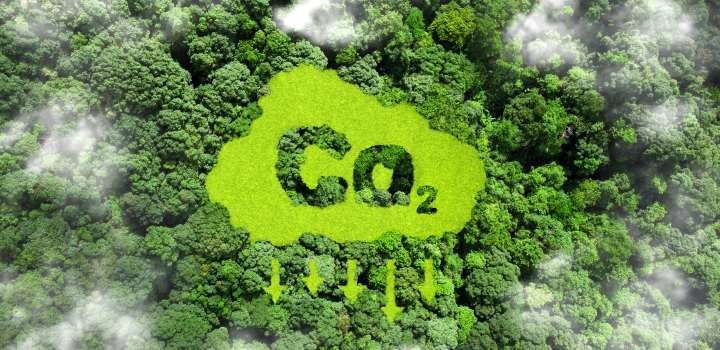Rather than cutting emissions and phasing out fossil fuels more quickly, governments and companies depend on the hazardous quantities of carbon dioxide (CO2) that will eventually be removed from the atmosphere in the future.
 Governments and businesses are relying on dangerous amounts of future removal of carbon dioxide (CO2) from the atmosphere, instead of more rapidly reducing emissions and phasing out fossil fuels. Image Credit: University of East Anglia
Governments and businesses are relying on dangerous amounts of future removal of carbon dioxide (CO2) from the atmosphere, instead of more rapidly reducing emissions and phasing out fossil fuels. Image Credit: University of East Anglia
According to a recent study from the University of East Anglia and collaborators, which was published in Science, this issue is partially caused by an insufficient understanding of the detrimental effects of carbon dioxide removal on humans, food security, and natural ecosystems.
The Intergovernmental Panel on Climate Change (IPCC), the UN body responsible for assessing climate science, currently reports carbon dioxide removal potential that, according to the study, greatly overstates how much heavy lifting—specifically, bioenergy with carbon capture and storage and tree-planting—carbon dioxide removal can safely accomplish to meet climate targets.
When drafting and disseminating its reports, the IPCC compiles the finest available research.
Researchers are now able to map carbon dioxide removal alternatives against sustainability risks to determine what would maintain climate policy goals without generating unacceptable dangers. This has been made possible by scientific advances in recent years that have improved knowledge of how to slow and stop global warming.
The message of this study is clear: we must be realistic on the amount of carbon removal that is achievable without wrecking nature or driving food prices through the roof. The argument that ‘there’s not enough land’ is not itself novel, but what this study does is to show the devastating consequences of over-reliance on imaginary climate solutions.
Dr. Phil Williamson, Study Co-Author, School of Environmental Sciences, University of East Anglia
Lead author Alexandra Deprez, of independent policy research institute IDDRI and French university Sciences Po, added, “Governments and industries are banking on large future deployments of carbon dioxide removal to deliver the Paris Agreement climate goals, but the scale proposed threatens food security, human rights, poses serious damage to natural ecosystems and risks overstepping multiple planetary boundaries in potentially irreversible ways.”
The researchers looked at the pathways restricting warming to 1.5 °C as well as the published climate science that served as the basis for the most recent IPCC assessments.
After applying the risks to human livelihoods and biodiversity to the various scenarios, they discovered that the sustainable thresholds for land-based carbon dioxide removal using bioenergy crops, forestry, and ecosystem restoration are substantially lower than deployment expectations conveyed by most pathways presented in the IPCC reports.
The levels of carbon dioxide removal that are considered to be feasible at reasonable cost by the IPCC create high risks for agriculture, livelihoods and the environment. That is because there isn't enough land on our planet for huge amounts of carbon dioxide removal - something else has to give. Biodiversity, freshwater use, and food security should be the issues that guide limits to carbon dioxide removal rather than current estimates of technical and economic potentials.
Paul Leadley, Study Co-Author and Professor, University of Paris-Saclay
The challenge of meeting the lofty climate targets set forth in the Paris Agreement is addressed in the most recent IPCC mitigation report (AR6 WGIII), in part by outlining the practical and financial constraints on carbon dioxide removal alternatives.
Afforestation/reforestation (maintaining, improving, or planting new forests) and the upper end of the proposed ceiling for bioenergy with carbon capture and storage, when taken into account as land area, could require converting up to 29 million km2 of land—more than three times the area of the United States—to bioenergy crops or trees.
This has the potential to put over 300 million people—nearly the whole US population—into food insecurity.
According to an analysis of current climate commitments, by the end of this decade, countries aim to use 12 million km2 for land-based carbon removal by 2060, which is nearly the entire amount of currently available global cropland, and produce twice as much fossil fuel as advised in the IPCC Paris-aligned pathways with low or no overshoot past 1.5 ℃.
Carbon dioxide removal into land and forests cannot legitimately be used to offset continuing fossil fuel emissions. Government climate plans should set separate, transparent targets for emission reductions and removals, which limit reliance on the latter, and meet climate and biodiversity commitments through restoring and maintaining natural ecosystems.
Dr. Kate Dooley, Study Co-Author, University of Melbourn
Three suggestions are made by the study for scientists and policymakers:
- Determine a sustainable budget for the removal of carbon dioxide (CDR) using the socio-ecological limit.
- Identify potential 1.5 °C pathways that do not overstep sustainability CDR limits, with a concentration on near-term national climate plans (NDCs) required in 2025 under the UNFCCC process.
- Limited sustainable supply should be distributed to the majority of legitimate users under CDR governance.
In the second half of this crucial decade for climate action, the research also asks the scientific community to provide input for the upcoming cycle of IPCC reports. For the seventh cycle of the IPCC assessment report (AR7), identifying Paris-aligned scenarios that do not exceed sustainability limitations should be the primary emphasis.
Journal Reference:
Deprez, A., et. al. (2024) Sustainability limits needed for CO2 removal. Science. doi:10.1126/science.adj6171.